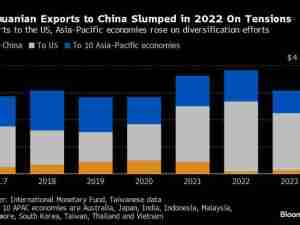Gains in Japan’s exports widened for the first time since May as the country’s key auto shipments recovered and global trade showed signs of regaining traction before the omicron variant of the coronavirus began its spread.
Higher exports of steel and semiconductor equipment helped lift the overall value of Japanese shipments 20.5% from last year’s level, the finance ministry reported Thursday in figures that were closely in-line with estimates. The gains were more than double October’s.
Stronger Japanese exports are good news for the country’s recovery prospects. They also add to signs that easing supply constraints were helping to put the global economy on a better footing in the weeks before the emergence of the omicron virus variant introduced a new element of uncertainty.
Japan’s import figures, though, showed more evidence of the rising cost pressures that are driving up inflation around the world and squeezing profits for Japanese businesses. Imports of crude oil, the price of which has surged, more than doubled from last year and played a big role in creating the biggest trade deficit since January 2020.
“We saw a bit of relief in supply constraints in November, but there’s a risk that the omicron variant could halt factories abroad and increase supply constraints like the delta variant did,” said economist Koya Miyamae at SMBC Nikko Securities Inc. “A weaker yen is making oil imports even more expensive, which will work against consumption at home.”
November’s export gains were broad-based, with shipments to the U.S., China and the EU all logging their strongest increases since summer. Japan’s car exports, a key driver of the economy, increased about 4%, recovering from a fall of more than a third the previous month, even as supply chain snarls persist.
What Bloomberg Economics Says…
“Looking ahead, we expect exports to increase in December on strong demand from the U.S. Uncertainty due to the omicron variant is a downside risk.”
—Yuki Masujima, economist
With rising prices for gasoline and other select items causing some concern that Japan’s consumers might pull back, the pressure for exports to carry the recovery increases. Analysts see the economy bouncing back at the end of the year after shrinking last quarter for a fifth time in eight quarters.
Still, the spread of the omicron variant since late November now clouds the outlook to some extent, as countries limit access to travelers and weigh whether to reinstate domestic restrictions. Supply bottlenecks also continue to affect manufacturers, with Toyota Motor Corp. cutting production again this month due to parts shortages.
“Overall there’s a recovery in exports led by cars,” said economist Takeshi Minami at Norinchukin Research Institute. “But it’s likely to remain quite slow. Toyota’s already said their December plan of getting their production levels back is facing delays, and it’s still unclear whether it’ll get back on track in January given Southeast Asia is still facing Covid problems.”



